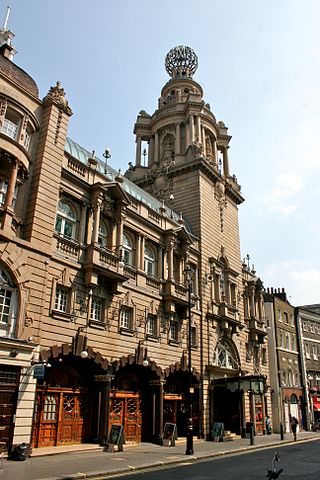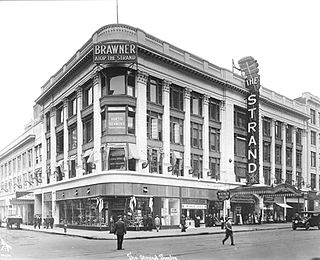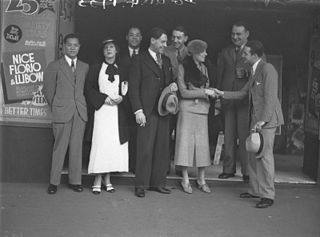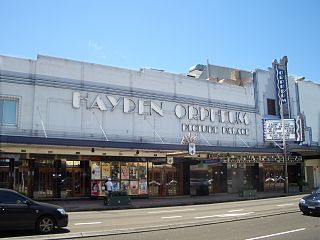
Bondi Junction is an eastern suburb of Sydney, in the state of New South Wales, Australia. It is 6 kilometres east of the Sydney central business district and is part of the local government area of Waverley.

The Empire, Leicester Square is a cinema currently operated by Cineworld on the north side of Leicester Square, London, United Kingdom.

The Odeon Luxe Leicester Square is a prominent cinema building in the West End of London. Built in the Art Deco style and completed in 1937, the building has been continually altered in response to developments in cinema technology, and was the first Dolby Cinema in the United Kingdom.

The Cinerama Dome is a movie theater located at 6360 Sunset Boulevard in Hollywood, California. Designed to exhibit widescreen Cinerama films, it opened November 7, 1963. The original developer was William R. Forman, founder of Pacific Theatres. The Cinerama Dome continued as a leading first-run theater, most recently as part of the ArcLight Hollywood complex, until it closed temporarily in March 2020 due to the COVID-19 pandemic in California. The ArcLight chain closed permanently in April 2021, with the theater never having reopened. In June 2022, it was announced that there were plans to reopen it and the former ArcLight Hollywood under a new name, Cinerama Hollywood.

The London Coliseum is a theatre in St Martin's Lane, Westminster, built as one of London's largest and most luxurious "family" variety theatres. Opened on 24 December 1904 as the London Coliseum Theatre of Varieties, it was designed by the architect Frank Matcham for the impresario Oswald Stoll. Their ambition was to build the largest and finest music hall, described as the "people's palace of entertainment" of its age.
Greater Union Organisation Pty Ltd, trading as Event Cinemas, Greater Union, GU Film House, Moonlight Cinema and Birch Carroll & Coyle, is the largest movie exhibitor in Australia and New Zealand, with over 140 cinema complexes currently operating worldwide.

The Somerville Theatre is an independent movie theater and concert venue in the Davis Square neighborhood of Somerville, Massachusetts, United States. Over one hundred years old, the Somerville Theatre started off as a vaudeville house and movie theater. The theater has since transitioned and now operates as a live music venue and first-run movie theater. As a music venue, the theater has played host to many historic concerts, including the first of the two Last Dispatch concerts, two shows by Bruce Springsteen in 2003, and a performance by U2 in 2009. Recent live performances have included Ryan Adams & the Cardinals, Cursive, Norah Jones, The Jonas Brothers, Joan Baez, and the John Butler Trio.

The Odeon Marble Arch was a cinema in London located opposite Marble Arch, at the top of Park Lane, with its main entrance on Edgware Road. It operated in various forms from 1928 to 2016, and is most famous for once housing a vast screen capable of screening films in 70mm. The machines were Cinemeccanica Victoria 8 models.

The Strand Theatre was an early movie palace located at 1579 Broadway, at the northwest corner of 47th Street and Broadway in Times Square, New York City. Opened in 1914, the theater was later known as the Mark Strand Theatre, the Warner Theatre, and the Cinerama Theatre. It closed as the RKO Warner Twin Theatre, and was demolished in 1987.

The State Theatre is a 2034 seat heritage listed theatre located at 47–51 Market Street, in the Sydney central business district in the City of Sydney local government area of New South Wales, Australia. The theatre was designed by Henry Eli White with assistance from John Eberson and built between 1926 and 1929. It hosts film screenings, live theatre and musical performances, and since 1974 it has been the home of the annual Sydney Film Festival. It is also known as State Building and Wurlitzer Organ. The property is privately owned. It was added to the New South Wales State Heritage Register on 2 April 1999.

The former Plaza Theatre in Sydney, New South Wales is a heritage-listed building designed as a 2000-seat cinema by Eric Heath for the Hoyts Group, and opened in 1930. It is no longer used as a cinema.

The Sun Theatre is an eight-screened cinema located in Melbourne, Australia, in the inner-west suburb of Yarraville.
Palace Cinemas is an Australian cinema chain that specialises in arthouse and international films.

The Criterion Theatre was a theatre in Sydney, Australia which was built in 1886 by architect George R Johnson on the south east corner of Pitt and Park streets. It closed in 1935 and the building was demolished.

The New Tivoli Theatre, Sydney, previously known as the Adelphi Theatre and the Grand Opera House, was a theatre and music hall at 329, Castlereagh Street, Sydney, Australia, which was long at the heart of the Tivoli circuit.

Henry Eli White, also known as Harry White, was a New Zealand-born architect best known for the many theatres and cinemas he designed in New Zealand and Australia in the 1910s and 1920s. Many of the major surviving historic venues in the two countries are White designs, including the St. James Theatre, Wellington, St. James Theatre, Auckland, the Capitol Theatre and State Theatre in Sydney, and the Palais Theatre and the interiors of the Princess Theatre and Athenaeum Theatre in Melbourne. He also designed the City Hall and the attached Civic Theatre in Newcastle, New South Wales.

The Hayden Orpheum Picture Palace, also known and originally as the Cremorne Orpheum Theatre, is a heritage-listed cinema located at 380 Military Road, in the northern Sydney suburb of Cremorne in the North Sydney Council local government area of New South Wales, Australia. It was designed by George Newton Kenworthy and built in 1935 by F. T. Eastment and Sons. It was added as a Heritage Item to the North Sydney Local Environmental Plan 2013 on 2 August 2013.

Piccadilly Cinema(s), formerly Piccadilly Theatre and Forum Cinema, and also known as The Piccadilly, is a cinema located on the corner of O'Connell Street and Childers Street in North Adelaide, South Australia.
Wondergraph, Wondergraph Theatre and variations were names given first to a technology, and then to picture theatres run first by the Continental Wondergraph Company ; and then, in Adelaide, South Australia, by the Wondergraph Company (1910–1911), and then the Greater Wondergraph Company, established around 1911 and in existence until 1939.
The Odeon Star Semaphore Cinemas, usually referred to as the Odeon Star, is an independent multiplex cinema in the beachside Adelaide suburb of Semaphore, South Australia. It is the oldest purpose-built cinema in Adelaide, opened on 22 May 1920 as the Wondergraph Picture Palace.


















